8 Common Foods High in Gluten to Avoid for a Gluten-Free Diet
Top Sources and Dietary Considerations
Gluten, a protein found in wheat, barley, and rye, is a common ingredient in many everyday foods. For individuals with gluten intolerance or celiac disease, consuming gluten can lead to a range of health issues, making it essential to identify and avoid foods containing this protein.
Understanding which foods are high in gluten is crucial for anyone needing to follow a gluten-free diet. By exploring common foods and ingredients that contain gluten, individuals can make informed choices to maintain their health and well-being.
1) White Bread
White bread is a common dietary staple for many. Made primarily from wheat flour, it contains significant amounts of gluten. This type of bread includes products like sandwich loaves, dinner rolls, and various types of buns.
The wheat flour used in white bread undergoes a refining process that removes the bran and germ. Despite this, gluten remains a key component, providing the dough with elasticity and structure.
For individuals with gluten intolerance or celiac disease, consuming white bread can lead to adverse health effects. Symptoms may include digestive issues, fatigue, and other discomforts.
It is essential for those requiring a gluten-free diet to avoid white bread unless specifically labeled as gluten-free. Many alternatives are available, such as breads made from rice flour, almond flour, or other gluten-free grains.
In grocery stores, gluten-free white bread options often utilize alternative ingredients to mimic the texture and taste of traditional white bread. Checking labels carefully can help in making safe choices for those with gluten sensitivities.
2) Bagels
Bagels are a popular breakfast food that contain high amounts of gluten.
Traditional bagels are made using wheat flour, which is rich in gluten. Gluten lends bagels their characteristic chewy texture, which is achieved through kneading the dough and boiling it before baking.
Variations such as flavored bagels or those with additions like sesame seeds or poppy seeds also contain gluten.
Those on a gluten-free diet should avoid regular bagels and opt for gluten-free alternatives. These substitutes typically use gluten-free flours like rice or tapioca flour.
For those with gluten intolerances or celiac disease, checking labels is essential to ensure the product is truly gluten-free.
3) Pretzels
Pretzels are a popular snack that come in various shapes and flavors. Made primarily from wheat flour, they are inherently high in gluten. Gluten is a protein found in wheat, barley, and rye.
Many pretzels, including both hard and soft varieties, contain a significant amount of gluten due to their wheat-based dough. This makes them unsuitable for individuals with celiac disease or gluten sensitivity.
Beyond just the basic ingredients, some pretzels are filled with additional gluten-containing products like peanut butter or cheese, further increasing their gluten content.
In grocery stores, pretzels are often available in multiple flavors and coatings, but unless specifically labeled as gluten-free, they should be avoided by those needing to limit gluten intake.
For those monitoring their gluten consumption, it's important to carefully check labels and opt for gluten-free certified pretzel brands if needed.
4) Couscous
Couscous is commonly made from semolina wheat. This grain contains gluten, making traditional couscous unsuitable for those with celiac disease or gluten sensitivity.
Most couscous found in grocery stores and restaurants is not gluten-free. It is often used in a variety of dishes such as salads, soups, and stews.
Individuals on a gluten-free diet should be cautious. Only couscous explicitly labeled as gluten-free, made from alternatives like corn, rice, or quinoa, is safe for consumption.
Care should be taken when dining out. Trust only establishments that guarantee gluten-free options.
5) Seitan
Seitan, also known as wheat gluten, is a popular meat substitute among vegans and vegetarians. It's made by kneading wheat flour with water to form a dough. This dough is then washed to remove the starch, leaving behind the gluten protein.
Seitan is exceptionally high in protein, often comparable to animal-based sources like chicken. In a 100-gram serving, it provides about 25 grams of protein, making it a valuable addition to plant-based diets.
Despite its nutritional benefits, seitan is not suitable for everyone. People with gluten intolerance, celiac disease, or wheat allergies should avoid it, as it can cause adverse effects such as bloating, diarrhea, and abdominal pain.
Additionally, seitan can be high in sodium, especially when processed or pre-packaged. Checking labels and opting for homemade versions can help control sodium intake.
When cooked properly, seitan can mimic the texture of meat, making it versatile in various recipes. It can be steamed, fried, or baked and is often used in dishes like stir-fries, sandwiches, and stews.
6) Spelt Bread
Spelt bread is made from spelt, an ancient grain and a specific type of wheat. Like all wheat products, spelt contains gluten, a protein that helps give dough its elasticity and chewiness.
Spelt bread is often marketed as healthier than regular wheat bread due to its nutrient profile. It is rich in carbs, fiber, and several essential vitamins and minerals.
Despite its health benefits, spelt bread is not suitable for individuals with celiac disease or gluten sensitivity. The gluten in spelt can trigger symptoms in these individuals, similar to other gluten-containing grains like barley and rye.
For those who can tolerate gluten, spelt bread can be a tasty and nutritious alternative to conventional wheat bread. However, it is crucial to note that it still contains gluten and should be avoided by those on a gluten-free diet.
7) Barley
Barley is a cereal grain frequently used in various culinary applications, including soups, stews, and beer production. Its chewy texture and nutty flavor make it a popular choice for enhancing dishes.
Barley contains gluten, making it unsuitable for individuals with celiac disease or gluten sensitivity. Gluten proteins found in barley can trigger adverse reactions in these individuals.
This grain is not just limited to whole grains. It also appears in processed forms like barley flour and malt. Manufacturers often use these derivatives in baked goods, sauces, and beverages.
Due to these factors, identifying and avoiding barley is crucial for anyone following a gluten-free diet. Always check labels for barley or its derivatives in packaged foods.
8) Rye Bread
Rye bread is a popular choice among many due to its distinct, hearty flavor.
This bread is made using rye flour, which contains gluten. Though rye flour has slightly lower gluten content compared to wheat flour, it is still not suitable for those with gluten intolerance or celiac disease.
Rye bread typically contains around 10-15 grams of gluten per 100-gram slice.
Dark rye bread tends to have a higher gluten content since it's made from whole rye flour, while light rye bread uses a blend of rye and wheat flours.
Rye bread is also rich in essential B vitamins such as thiamin, niacin, and vitamin B6. These vitamins play significant roles in energy production and brain health.
It's worth noting that rye bread can sometimes be high in added sugars, depending on the recipe and region.
Despite its health benefits, those on a strict gluten-free diet should avoid rye bread entirely.
9) Pasta
Pasta is a common high-gluten food made primarily from wheat flour. Varieties like spaghetti, fettuccine, and macaroni all contain significant amounts of gluten.
Individuals with gluten intolerance or celiac disease should avoid traditional pasta. Semolina and durum wheat, used in most pasta, are high in gluten proteins.
Alternative options include gluten-free pasta made from ingredients like quinoa, chickpeas, or rice. These substitutions provide similar textures without the gluten content.
10) Beer
Beer is a well-known source of gluten, primarily because it is commonly made from barley and wheat. These grains are rich in gluten proteins, which contribute to the beer’s structure and flavor.
The gluten content in beer can vary widely. Some craft beers may have higher gluten levels, while certain lagers and pilsners might have comparatively lower amounts.
For individuals with celiac disease or gluten intolerance, even a small amount of gluten can cause adverse reactions. It's essential to be aware that some beers contain gluten levels of up to 361 ppm, depending on the brewing process and ingredients used.
Although some beers are labeled gluten-free, they must contain less than 20 ppm of gluten. This makes them safer for people with gluten sensitivities but not completely free of gluten.
Stouts and certain types of ales tend to have higher gluten content, sometimes averaging around 360 ppm. This makes them particularly important to avoid for those on a strict gluten-free diet.
Regular consumption of beer with high gluten levels can exacerbate gluten-related health issues. For those needing to avoid gluten, opting for gluten-free alternatives or other beverages is advisable.
Understanding Gluten
Gluten is a group of proteins found mainly in wheat, barley, and rye. It plays a crucial role in food structure and quality but can have adverse effects on certain individuals.
What Is Gluten?
Gluten is a composite of storage proteins, primarily glutenin and gliadin, found in grains like wheat, barley, and rye. It imparts elasticity to dough, allowing it to rise and maintain its shape. Additionally, gluten gives a chewy texture to baked products.
In wheat, for example, gluten forms when water mixes with flour, activating the proteins to create a stretchy matrix. This characteristic makes it valuable in baking and food preparation.
How Gluten Affects the Body
For most people, gluten is harmless and adds beneficial texture to foods. However, individuals with celiac disease or non-celiac gluten sensitivity experience adverse reactions.
In celiac disease, gluten triggers an immune response that damages the small intestine's lining, impairing nutrient absorption. Symptoms include abdominal pain, bloating, and diarrhea.
Non-celiac gluten sensitivity leads to similar symptoms without causing intestinal damage. A strict gluten-free diet is essential for managing these conditions and preventing complications.
Health Implications
Understanding the health implications of foods high in gluten is essential. Certain individuals may experience significant adverse effects, including gluten sensitivities, allergies, and celiac disease.
Gluten Sensitivities and Allergies
Gluten sensitivity involves adverse reactions to gluten, which is a protein found in wheat, rye, barley, and spelt. Individuals may experience symptoms such as abdominal pain, bloating, fatigue, and headaches.
Unlike celiac disease, gluten sensitivity does not trigger an autoimmune response. Testing for gluten sensitivity can be challenging because there are no specific biomarkers. Management typically involves a gluten-free diet. Additionally, gluten allergies, which are less common, can result in hives, nausea, and even anaphylaxis in extreme cases.
Celiac Disease
Celiac disease is an autoimmune disorder where gluten consumption damages the small intestine's lining, preventing nutrient absorption. Symptoms include diarrhea, weight loss, and nutrient deficiencies.
Diagnosis involves blood tests and intestinal biopsies to confirm the autoimmune response to gluten. Management is strict adherence to a gluten-free diet to prevent further intestinal damage and alleviate symptoms. Regular follow-ups with healthcare providers ensure nutrients are adequately absorbed and maintained.






